Chain Bridge
The Chain Bridge was the first permanent stone-bridge connecting Pest and Buda, and only the second permanent crossing on the whole length of the river Danube. It is one of the symbolic buildings of Budapest, the most widely known bridge of the Hungarian capital.
Its construction was proposed by Count István Széchenyi, one of the leading figures in 18th century Hungary. Its official name is Széchenyi Chain Bridge. Works were started in 1839 to the plans of English engineer William Tierney Clark with the financial support of Baron György Sina, a Viennese financier. The construction was supervised by Scottish engineer Adam Clark, who later on went on to marry a Hungarian girl and settled down in Hungary. The place at the Buda end of the bridge has been named after him. The inauguration of the Chain Bridge took place on 20 November 1849.
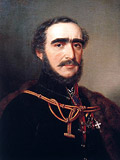 Count István Széchenyi (1791-1860) |
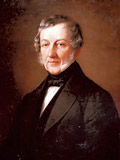 William Tierney Clark (1783-1852) |
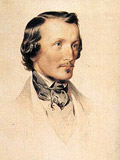 Adam Clark (1811-1866) |
The iron chains, on which the road-bed hangs, are held by two 48-meter river piers in classicist style. From here comes the name "Chain Bridge". The chain-links have been made of iron plates with a length of several meters, its parts are connected by large rivets allowing for the chain to be a real chain and to make small movements. The chains have been led through the top part of the pillars where they rest on large iron saddles. Between the two pillars, the chains are hanging low, and outside the pillars, they lead to the riverbanks where they go underground with minor fractures. Here, deep underground you can find the so-called chain-chambers in which the descending chain-ends are being anchored by vast iron blocks leaning to the walls of the chambers.
At the time of its construction, the Chain Bridge was the suspension bridge with the second-largest span in the world. The portals are decorated with lionhead-shaped capstones and the coat of arms of Hungary with the crown and a wreath of leaves.
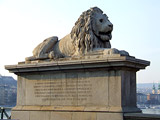 Stone lion |
The stone lions situated at both abutments have been carved by sculptor János Marschalkó. These, however, took their allotted places only in 1852. At the Buda end, their plinth also contains the coats of arms of the families Széchenyi and Sina cast by András Gál. They have luckily survived the destruction of World War II. It is a widespread urban legend in Budapest that the lions of the Chain Bridge do not have tongues. The legend lacks any factual basis, the lions do very well have tongues, however, these can only be seen from above.
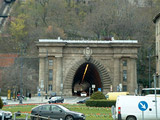 Tunnel under the Buda Castle |
Those coming from the Pest end had to walk round the Castle Hill on the Buda side to be able to proceed northwards. On 10 February 1853, four years after the completion of the Chain Bridge, the building of a tunnel leading through the hill was started to the plans of Adam Clark. On 6 March 1856, the tunnel was opened for foot traffic, and on 30 April 1857 also for motor traffic. Being 350 meters in length, it leads through under the Buda Castle to the other side of the hill. Its length is approximately identical to that of the Chain Bridge, prompting anecdotes according to which the tunnel has only been built so that in rainy weather, the Chain Bridge can be shoved in and be protected from wet conditions. The entry of the tunnel at its Chain Bridge end was also fittingly designed in classicist style.
Around the end of the century, the traffic on the bridge increased rapidly, so that it had to be fortified. A decision was made to replace the ironwork completely. According conversions were started in 1913. The broadening of the bridge seemed necessary as well, but the responsible gave up on this plan, as they did not want to touch the vast pillars of the bridge. Special attention had to be paid to the objective not to change the appearance of the bridge in the course of the modification, so that a structure quite similar to the original was designed, leaving unchanged visible parts of the pillars and abutments. The main pillars were being fortified in order to hinder their displacement in the case of a larger pulling power. The bridge was reopened for traffic on 27 November 1915 and rechristened Széchenyi Chain Bridge.
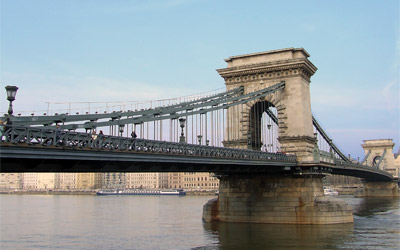
Chain Bridge was the first permanent stone-bridge connecting Pest and Buda
In 1918, a further significant change took place in the life of the Chain Bridge: bridge moneys were done away with completely.
At the end of World War II, retreating German troops blew up all bridges of Budapest, among them also the Chain Bridge on 18 January 1945. The bridge was destroyed nearly completely, only its pillars remained intact. The decision to rebuild it was made in the spring of 1947. The construction work was started: pillar portals were being extended, abutments broadened, custom-houses pulled down, a pedestrian subway installed at the Buda end and the tram subway completed on the Pest side. The inhabitants of Budapest were finally able to repossess one of the most renowned buildings of the city on 20 November 1949, exactly hundred years after its initial inauguration.
The first festive illumination of the bridge was installed in 1937, for a visit of Italian king Victor Emmanuel III and Austrian chancellor Schuschnigg. The present illumination is composed by two parts: the top and the bottom parts of the pillars are illuminated by reflectors, and a beading of light bulbs runs along the top chains and the edges of the pavements to emphasize the shape of the ironwork.
The Budapest City Protection Society embedded a bilingual plaque in the plinth of a candelabrum situated at the southern part of Roosevelt Square at the Pest side: "To commemorate the only two surviving bridges designed by William Tierney Clark: The Széchenyi Chain Bridge over the Danube at Budapest and the suspension bridge over the Thames at Marlow - England." A similar text can be read at a plaque placed at the Marlow Bridge. The Neo-Renaissance building of the Hungarian Academy of Sciences, inaugurated on 11 December 1865 can also be found at Roosevelt Square. Directly in front of Chain Bridge, at its Pest end rises Gresham Palace, a distinguished example of the Art Nouveau in Hungary. At present, it serves as a branch of Four Seasons Hotels.
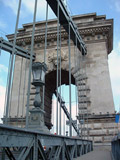 The two river piers are 48 meters high |
The whole length of the bridge amounts to 380 meters, it is 14.8 meters in width. It contains two traffic lanes, being only 6.45 meters wide each, and pavements at the two rims, walking on which you can enjoy a magnificent view of the Parliament on the Pest side. The Chain Bridge and the Parliament, their glittering night illumination mixing with other lights of the city are being reflected astoundingly on the dark surface of the river Danube. If you want to admire the building of the Parliament also from the front, you should take a 10 minutes' walk from the Buda end of the bridge northwards to Batthyány Square.
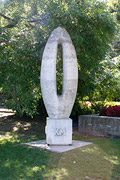 The milestone "0" |
The square at the Buda end of the bridge has been named after Adam Clark. Its centre is decorated with radiant flowers from spring to autumn. You can also find an oddly shaped oval stone here, the milestone "0" carved by Miklós Borsos. It has been placed on the south-western part of the square since 1975, and it marks the fact that the main roads of Hungary all set off here, making it the starting point for the counting of kilometers. The square also hosts one of the termini of the Buda Hill Funicular which takes you up to Buda Castle within a couple of minutes, from where you can enjoy a beautiful view of the panorama of Budapest with the Chain Bridge.
|
|||||||||||||||||||||||||||||||||||||||||||
|
|||||||||||||||||||||||||||||||||||||||||||
External links
- Gresham Palace - A luxury hotel in Budapest very close to the Chain Bridge
- Parliament - The Hungarian Parliament
BRIDGES OF BUDAPEST
DID YOU KNOW?
In the course of World War II, all bridges of Budapest were demolished so that after the war, a need for quickly buildable provisional bridges arose. Kossuth Bridge was opened for traffic on 18 January 1946. After the inauguration of the rebuilt Chain Bridge, Kossuth Bridge was closed for traffic and finally demolished in 1960.


